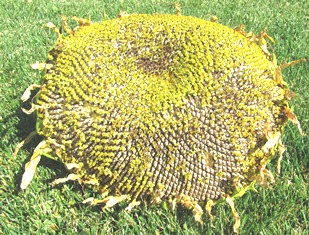Giant Sunflowers Provide Food and Fun for Everyone
Giant sunflowers need space to grow to full size; they can reach six or more feet tall. Bees love them for their pollen. Kids love them when the foliage of the plants create a secret fort or a fairy circle. Humans, birds, and squirrels love them for their seeds.
For best results, plant giant sunflowers at the back of a garden. They need good soil and full sun. Plant when the danger of frost has past. A rule of thumb to follow is to plant them about one inch deep and six inches apart. While the seeds are germinating, keep the soil moist.
Later on, when the plants stand about three inches tall, you can begin to thin them. Leave about one foot between each plant. This can enable a strong root system for form. The stalks will become sturdy and measure about three to four inches in circumference when fully grown.
First come the gorgeous petals in green to yellow and then bright yellow. As the bees pollinate the florets and they drop, the seeds will mature. Seeds are either gray or brown in color.
I always cut the heads when the seeds are plump, firm, and begin to drop. I let the heads dry well in the sun for days before I remove the seeds. Fully dry seeds can be stored in containers for human consumption or to be fed to the squirrels and birds.
* * *
If you enjoy reading about farmette topics (including gardening, beekeeping, and delicious recipes), check out my cozy mysteries A BEELINE TO MURDER and also THE MURDER OF A QUEEN BEE in the Henny Penny Farmette series (from Kensington Publishing).
These novels are available through online retailers such as Amazon, Barnes & Noble, Kobo Books, and Walmart as well as from traditional bookstores everywhere.
See, http://tinyurl.com/hxy3s8q
Now available in mass market paperback, this debut novel launched the Henny Penny Farmette series of mysteries and sold out its first press run.
See, http://tinyurl.com/h4kou4g
The second cozy mystery in the Henny Penny Farmette series, available Sept. 27, 2016
Giant Sunflowers Are Fun for Kids and Easy to Grow
Today, I harvested the largest sunflower in my garden. The 119-inch stem (almost 10 feet) had bent over from the weight of the 15-inch seed head.
The seeds of this annual were already drying and starting to drop from the head. Since I want to harvest and store them, I don’t want to risk new plants emerging from where the seeds have drop onto soil. And I don’t want the squirrels to get the seeds before I’ve saved some.

Giant sunflower head, newly harvested, covered with florets that will dry and fall off or can be brushed off to expose seeds
The sunflower I grew emerged from a single stalk that bore only one head with sunny yellow-petaled face. I planted it from seed I saved last year from the parent. If you want a row of giant plants, you’ll need to space them about 20 inches apart.
Kids love these giants when they are trained to grow in fairy rings, fortlike squares, or as tee-pees. The plants are much appreciated by the honeybees, squirrels, and songbirds. Best of all, the stalks can go into the compost pile when the growing season is over.
Our farmette soil is clay. In the area where I planted these sunflowers, I amended the soil with chicken manure and peat. The seedd went in about 1 inch deep and five to six inches apart. Last year, we grew the sunflowers in a circle, but this year we have a row at the back of the property in front of a fence.
Once the seeds are planted, a thorough watering will help them germinate within about a week. Keep them moist until they germinate, then water on a regular basis. I feed them once during the growing cycle with a cup of fish emulsion diluted in a five-gallon bucket of water. Otherwise they aren’t too fussy about soil and can even withstand some drought conditions.
Find heirloom organic seed that is non-GMO at any of the following seed companies:
Baker Creek Heirloom Seeds at http://www.rareseeds.com/mammoth-grey-sunflower/
Victory Seeds at http://www.victoryseeds.com/helianthus_annuus_giant.html
High Mowing Organic Seed at http://www.highmowingseeds.com/organic-seeds-mammoth-sunflower.html
Bountiful Gardens at http://www.bountifulgardens.org/products.asp?dept=70
All Good Things Organic or AGTO Seeds at http://www.agtoseeds.com/products/organic-russian-mammoth-sunflower-seed
 Facebook
Facebook Goodreads
Goodreads LinkedIn
LinkedIn Meera Lester
Meera Lester Twitter
Twitter







